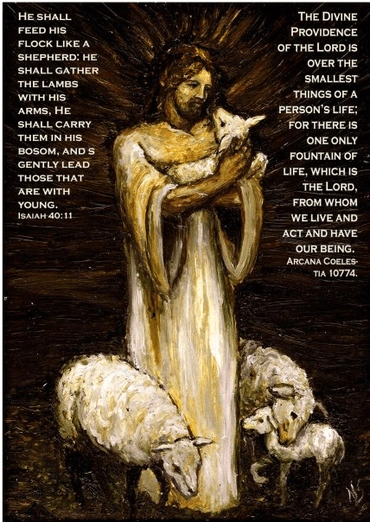44. And in the midst of the seven lampstands one like the Son of Man. (1:13) This symbolizes the Lord in relation to the Word, from whom that church originates.
People know from the Word that the Lord called Himself the Son of God and also the Son of Man. By "the Son of God" He meant Himself in respect to His Divine humanity, and by "the Son of Man" He meant Himself in relation to the Word. This we fully demonstrated in The Doctrine of the New Jerusalem Regarding the Lord, nos. 19-28 and since we confirmed it thoroughly from the Word there, we refrain from confirming it further here.
Now because the Lord presented Himself to John as the Word, therefore in His appearance to him He is called the Son of Man.
The Lord presented Himself as the Word because the subject is the New Church, which is a church founded on the Word, according to its understanding of it. To be shown that the church is founded on the Word, and that its character is such as its understanding of the Word, see The Doctrine of the New Jerusalem Regarding the Sacred Scripture, nos. 76-79.
Since the church is a church from the Lord by means of the Word, therefore the Son of Man appeared in the midst of lampstands. "In the midst" means, symbolically, in the inmost, from which those things that are round about or exterior to it draw their essence, in this case their light or intelligence.
That the inmost is everything in the things that are round about or exterior to it is something we showed many times in Angelic Wisdom Regarding Divine Love and Wisdom. It is like a light or flame at the center, in consequence of which all the peripheries shine with light and are warm.
[2] "In the midst" has the same symbolic meaning in the following passages in the Word:
Cry out and shout, O inhabitant of Zion, for great is the Holy One of Israel in your midst! (Isaiah 12:6)
God is my King..., working salvation in the midst of the earth. (Psalms 74:12)
...God...(working) lovingkindness in the midst of (the) temple.
God stands in the congregation of God; in the midst of the gods He will judge. (Psalms 82:1)
Gods are what those people who possess Divine truths from the Lord are called, and in an abstract sense, the truths themselves.
Behold, I am sending an angel before you... Beware of his presence...; for My name is in the midst of him. (Exodus 23:20-21)
The name of Jehovah means everything Divine. In the midst means in the inmost and so in every part.
In the midst or within symbolizes the inmost and so every part in many other places in the Word, even where the subject is evils, as in Isaiah 24:13, Jeremiah 23:9, Psalms 5:9, Jeremiah 9:5-6, and Psalms 36:1; 55:4; 62:4.
We have cited these places to make known that "in the midst of the lampstands" means, symbolically, in the inmost of the church, from which the church and everything connected with it originates; for the church and everything connected with it comes from the Lord through the Word.
To be shown that the lampstands symbolize a new church, see no. 43 just above.







